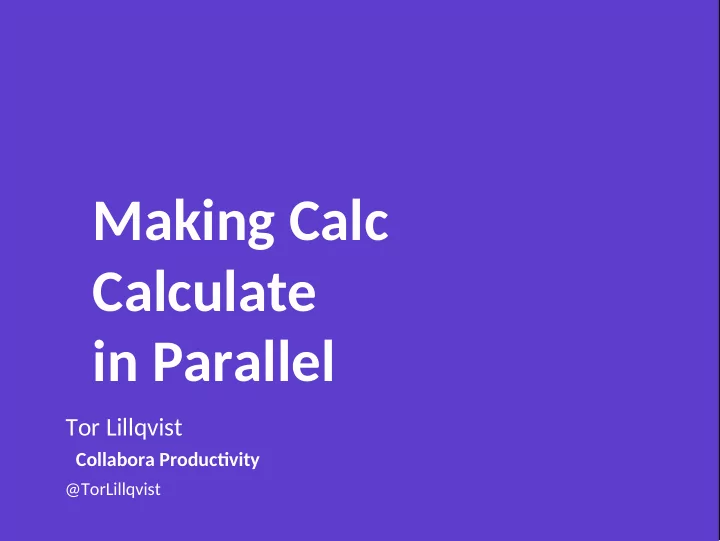

Making Calc Calculate in Parallel Tor Lillqvist Collabora Productvity @TorLillqvist www.collaboraofce.com
www.collaboraofce.com
Background
Background Number of cores in CPUs is increasing Relatively soon 8 cores will be commonplace Performance per core is not increasing so much www.collaboraofce.com
Background Calc so far single-threaded Performance will not improve much no matter how many cores the machine has OpenCL was supposed to be the solution Typically runs on GPU, but can also run on CPU For various reasons using OpenCL in LibreOffice did not work out as as nicely as expected The OpenCL-generating code is hideously complicated Very few developers even capable to work on it because of hardware/software issues www.collaboraofce.com
Background Formula groups Introduced as part of the OpenCL work some years ago Used when multiply sequential formulas in a column are “identical”: cell references are either absolute or to cells at an identical row and column offset For example: B1: =SUM(A$1:1)/D$1 + C1 B2: =SUM(A$1:2)/D$1 + C2 B3: =SUM(A$1:3)/D$1 + C3 Only done vertically. That is how repeated formulas occur in practice. www.collaboraofce.com
Background Each formula group is calculated as a whole, using either OpenCL or the “software interpreter” Input for those two calculation methods is collected into a packed vector of values, and output is stored in a such during computation. Afterwards the output is stored into the formula group’s cells. www.collaboraofce.com
www.collaboraofce.com
Future
Plans Instead of OpenCL, threading of Calc should thus be done using plain C++ code Lots of challenges with that Multi-threading aspects have not really been a concern when the Calc code has been written Data structures sub-optimal for multi-threaded use www.collaboraofce.com
What done Approach to be taken: Find the right place where to start threads, and just do it. Check what breaks. Fix. Iterate. Initial work done Results fairly promising For trivial but large sheets speedup in the order of number of threads www.collaboraofce.com
Future Eventually OpenCL could be retired Optionality of “software interpreter” should really go away. The less options the better. Use it automatically when it makes sense. www.collaboraofce.com
www.collaboraofce.com
Implementaton
Implementaton plan Add a fourth code path for formula cell calculation Existing: Plain traditional single-threaded, one formula cell at a time Formula group with “software interpreter” Formula group with OpenCL New: Formula group in parallel www.collaboraofce.com
Implementaton questons When to use the parallel calculation? When OpenCL is not available? Also when there is OpenCL, but the formula is not eligible for OpenCL? Should the “software interpreter” be preferred when eligible? www.collaboraofce.com
Implementaton Basic steps, examples: Make a few random static local variables thread-local case ScMatrixMode::Reference : { - static SCCOL nC; - static SCROW nR; + static thread_local SCCOL nC; + static thread_local SCROW nR; ScAddress aOrg; if ( !GetMatrixOrigin( aOrg ) ) return sc::MatrixEdge::Nothing; www.collaboraofce.com
Implementaton Basic steps, examples: Make a static local variable thread-local, or otherwise make the function multi-thread safe We used to have: bool ScT able::ValidQuery( SCROW nRow, const ScQueryParam& rParam, ScRefCellValue* pCell, bool* pbT estEqualCondition) { SCSIZE nEntryCount = rParam.GetEntryCount(); typedef std::pair<bool,bool> ResultT ype; static std::vector<ResultT ype> aResults; if (aResults.size() < nEntryCount) aResults.resize(nEntryCount); … Just revert this optimisation www.collaboraofce.com
Implementaton Basic steps, more: Move iterator index of FormulaTokenArray out of the class into separate class class FORMULA_DLLPUBLIC FormulaT okenArray { … FormulaT oken** pCode; // T oken code array FormulaT oken** pRPN; // RPN array sal_uInt16 nLen; // Length of token array sal_uInt16 nRPN; // Length of RPN array sal_uInt16 nIndex ; // Current step index FormulaError nError; // Error code Instead added a separate iterator class www.collaboraofce.com
Implementaton Run threads in ScFormulaCell:: InterpretFormulaGroup() Split work into as equal pieces as possible Use same minimum formula group size as for OpenCL. Except that we now use “weight,” not just size. Also number of input cells taken into account. www.collaboraofce.com
Implementaton Before running threads, calculate values of cells referenced by the formula where necessary, to avoid threaded recursive interpretation Make sure through assertions that when doing threaded calculation, shared data structures are not mutated. For example, don’t manipulate the formula “tree” (actually a list) while in threads www.collaboraofce.com
Implementaton A Calc document is represented by a ScDocument It also holds much stuff that is related to formula interpretation This is obviously a problem when running multiple interpreters (ScInterpreter) in parallel Move those fields into a new struct, ScInterpreterContext Allocate a such for each interpreter thread, pass around to functions that need it www.collaboraofce.com
Implementaton So far in experimentation it has worked surprisingly well Simple cases indeed speed up as expected But in some cases not that much Tweaks needed www.collaboraofce.com
Thanks to AMD for funding this work www.collaboraofce.com
www.collaboraofce.com
Thank you Tor Lillqvist @TorLillqvist tml@collabora.com
Recommend
More recommend